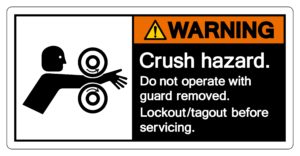Tag Archive: safety design analysis
-
Brian’s Areas of Expertise Include:
-
Safety Distance in Machine Safeguarding
Leave a CommentHazard can be defined as a potential source of harm. Machine safeguarding seeks to protect people from these potential sources of harm. Often distance from a hazard will play a key role in providing a means of protection.
One would often think of distance as it relates to the location of a barrier guard from a hazard. ANSI B11.19, Performance Criteria for Safeguarding, defines safety distance as “the distance a safeguard is installed from a hazard such that individuals are not exposed to a hazard.” An example from ANSI B11.19 of the recommended distance of a slotted opening in a barrier guard from a hazard is shown (more…)
-
Turkey Fryers- Product Design is Critical to Consumer Safety
Leave a CommentAs the holiday season nears, thoughts turn to wonderful home-cooked meals with family. Few things in life are more pleasurable than a traditional holiday turkey feast. Yet for an unfortunate few, holiday meal time can turn tragic if a turkey frying accident occurs. While fried turkeys may be tasty, many fire safety experts feel that the reward is not worth the risk. (more…)
-
Danger Within Reach
Leave a CommentHow far away from a hazard should you stay? Your parents or grandparents would probably have told you to stay far away, but what are you to do when a hazard is present, and you must work around or near the hazard? And what exactly is a hazard? ISO 12100 Safety of machinery – General principles for design – Risk assessment and risk reduction defines a hazard as a “potential source of harm.”
Where would a designer of a machine or product start if they wished to protect the user from a known hazard? Consensus standards are a great place to begin the quest for safety. (more…)
-
HEY…Cover Up Please!
Leave a CommentMachine guards can be compared to the clothes we wear every day. Indeed, they serve a very important purpose. Imagine someone leaving their home on a fine, sunny morning wearing nothing but a smile. Wonder how far they will get through the day before things start going poorly for this individual?

There will be more than a few raised eyebrows and blushes when he stops into the local Starbucks for his usual morning double-dipped and whipped, chocolaty chip with a touch of pumpkin spice cappuccino fix. Good luck with that! Probably going to leave disappointed, empty-handed, and likely wearing handcuffs. This will be the beginning of a very long, very bad day for that individual. Had he recognized the risks associated with this type of behavior, and then put forth a little effort to cover up, he would have prevented many unfavorable and possibly life-changing personal and legal problems from ever occurring!
And so it is with properly guarding a machine. Machine safeguarding helps to protect workers from preventable injuries. (more…)
-
WARREN Welcomes Mechanical Engineer Bob Hickman, P.E.
Leave a CommentPlease join us in welcoming Mechanical Engineer Bob Hickman, P.E., to the WARREN family! Bob has over 30 years of manufacturing and machine design experience in production and quality-driven environments. Bob holds a Bachelor of Science in Mechanical Engineering from Clemson University.
Bob’s Areas of Expertise Include:
-Machine Safeguarding
-Machine Design
-Equipment Failure
-Mechanical Engineering
-Industrial Accident Investigation
-Codes & Standards
-Machinery & Equipment Damage Assessment
-Products Liability (more…) -
The Concepts of Hazard, Risk, and Harm in Machine Safeguarding
Leave a CommentHazard, risk, and harm are terms that are used in the world of machine safeguarding. How do these words shape the concept of machine safeguarding? Let’s look a little deeper….
Hazard, which Merriam-Webster defines as a noun, lists its first meaning as a source of danger.
1: a source of danger
2a: the effect of unpredictable and unanalyzable forces in determining events : CHANCE, RISK
-
Warren Welcomes Fire Protection Engineer Amy Anderson, P.E.
Leave a CommentPlease join us in welcoming Fire Protection Engineer Amy Anderson, P.E., to the WARREN family! Amy has over 20 years of property loss prevention engineering and experience, specializing in fire protection. Amy graduated from Clemson University with a degree in Chemical Engineering and is a licensed Professional Engineer in Fire Protection.
Amy’s Expertise Includes: (more…)
-
The Role of Interlocking Guards in Injury Prevention
Leave a CommentIn the three-part series on the CE mark, we scratched the surface of some of the requirements an equipment manufacturer must meet in order to earn this designation. Part three of the series dealt with some of the requirements for the design of a guard. One of the items for consideration with the design of a guard is the frequency that someone will need to access the area protected by the guard. If access is needed on a routine basis, often defined as more than once per shift, the guard needs to be designed to be movable instead of fixed. Movable is defined as able to be opened without the use of tools. Otherwise the frustration and time requirements of obtaining tools and removing a fixed guard will often lead to the guard being discarded. (more…)
-
Don’t Get Burned With Your Gas Grill!
Leave a CommentIf there is one thing Americans can agree upon, it is the enjoyment that comes from an outdoor barbeque. Whether a summertime cookout or a fall BBQ to watch a football game, we all love the fun and fellowship that comes from sharing a meal that was prepared outdoors on a grill or smoker. In fact, 64% of Americans own a grill or smoker. The great majority of these are LP fueled gas grills with comparatively few natural gas fired grills. These products can be enjoyed safely when designed, installed, and used in a proper manner. However, given the grill’s use of flammable fuel gas and high temperatures, the potential exists for things to go wrong and result in burn injuries or uncontained fires that spread to the surroundings. (more…)

Type ofLoss
Not sure what you're looking for?
Browse All


